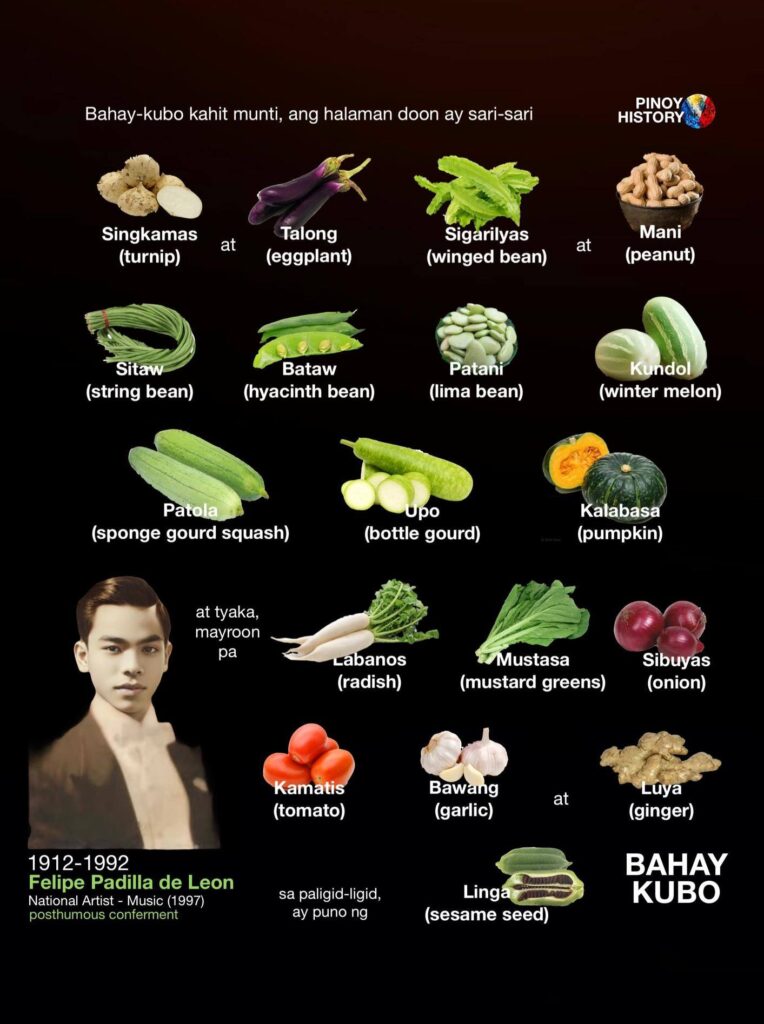
An ounce of prevention is worth a pound of cure.
Download The Six (6) Natural Anti-Cancer Super Cocktail Information
![]() => Anti-Cancer Information (PDF, 527 kb filesize)
=> Anti-Cancer Information (PDF, 527 kb filesize)
“Bahay Kubo”: The Iconic Filipino Folk Song That Grows with the Nation
In the heart of Filipino culture lies a charming and timeless folk song: “Bahay Kubo.” Simple, melodic, and rich in cultural imagery, this beloved tune has transcended generations as both a nursery rhyme and a cultural touchstone. More than just a children’s song, Bahay Kubo is a celebration of Filipino agricultural heritage, community life, and traditional values.
🌾 What Does “Bahay Kubo” Mean?
“Bahay Kubo” literally translates to “Nipa Hut”—a traditional Filipino rural house made of bamboo, wood, and thatched nipa palm leaves. These humble homes are typically found in the countryside and symbolize simplicity, harmony with nature, and self-sufficiency.
🎵 The Lyrics: A Garden of Filipino Vegetables
The song is a rhythmic list of vegetables growing around a typical bahay kubo, showing the abundance of Filipino agriculture. Here’s the traditional Tagalog version:
“Bahay kubo, kahit munti
Ang halaman doon ay sari-sari.
Singkamas at talong, sigarilyas at mani,
Sitaw, bataw, patani.
Kundol, patola, upo’t kalabasa,
At saka mayroon pang labanos, mustasa,
sibuyas, kamatis, bawang at luya,
sa paligid-ligid ay puro linga.”
🌿 English Translation:
“Nipa hut, even though it’s small,
The plants it houses are varied.
Jicama and eggplant, winged beans and peanuts,
String beans, hyacinth beans, lima beans.
White gourd, sponge gourd, bottle gourd and squash,
And there’s also radish, mustard,
Onions, tomatoes, garlic, and ginger,
All around are sesame seeds.”
🌱 Cultural Significance
“Bahay Kubo” is more than just a fun tune—it reflects key aspects of Filipino identity and values:
✅ 1. Simplicity and Sustainability
The song paints a picture of a small, modest home that thrives through natural abundance. It celebrates self-sufficiency and the beauty of rural life.
✅ 2. Agricultural Pride
By naming native vegetables, the song subtly teaches children about local crops and the importance of farming and food in everyday life.
✅ 3. Educational Value
Often taught in preschool and elementary schools, “Bahay Kubo” helps children learn:
The names of vegetables in Filipino
The concept of biodiversity
Rhyme, rhythm, and language skills
🎶 Musical Legacy
“Bahay Kubo” has been interpreted in many forms:
As a lullaby or children’s rhyme
In choral arrangements
With modern pop or folk instrumentals
Featured in Filipino films, animations, and cultural presentations
It remains a staple in Filipino music education and is often included in songbooks, school programs, and community festivals.
🇵🇭 A Symbol of National Heritage
Despite its simplicity, “Bahay Kubo” holds a deep cultural resonance. It represents a way of life that is deeply Filipino—one that values the land, cherishes community, and finds joy in the simple things.
In an era of rapid modernization, Bahay Kubo serves as a gentle reminder of the roots of Filipino identity and the traditions that continue to nourish the nation.
🏡 Final Thoughts
Whether sung by schoolchildren or remembered fondly by adults, “Bahay Kubo” continues to bloom in the hearts of Filipinos. It is not just a song—it’s a living reflection of the Philippines’ agrarian soul, a lullaby of abundance, and a gentle tribute to the land that provides.
Breast Cancer / Ovarian Cancer / Cervical Cancer / Lung Cancer / Liver Cancer / Colon Cancer / Leukemia / Melanoma / Prostate Cancer / Kidney Cancer / Stomach Cancer / Other Types of Cancer



